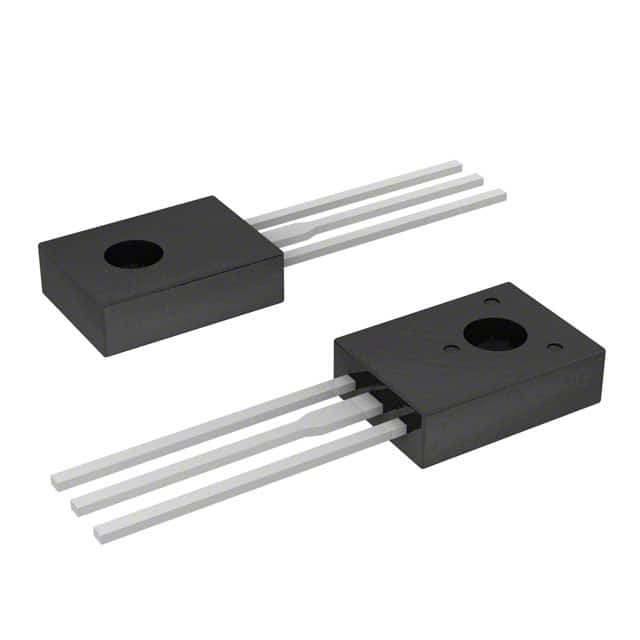BD434S Transistor
Product Overview
Category:
The BD434S transistor belongs to the category of semiconductor devices.
Use:
It is commonly used as a general-purpose amplifier or switching device in electronic circuits.
Characteristics:
- High current gain
- Low collector-emitter saturation voltage
- Medium power dissipation
Package:
The BD434S is typically available in a TO-126 package.
Essence:
This transistor is essential for amplifying and controlling electrical signals in various electronic applications.
Packaging/Quantity:
It is usually packaged individually and sold in quantities suitable for small to medium-scale projects.
Specifications
- Collector-Base Voltage (VCBO): 45V
- Collector-Emitter Voltage (VCEO): 45V
- Emitter-Base Voltage (VEBO): 5V
- Collector Current (IC): 4A
- Power Dissipation (PD): 36W
- Transition Frequency (ft): 2MHz
Detailed Pin Configuration
The BD434S transistor has three pins: the collector, base, and emitter. The pinout configuration is as follows: - Collector (C) - Pin 1 - Base (B) - Pin 2 - Emitter (E) - Pin 3
Functional Features
- High current gain allows for efficient signal amplification.
- Low collector-emitter saturation voltage enables minimal power loss during switching operations.
- Medium power dissipation ensures reliable performance under moderate load conditions.
Advantages and Disadvantages
Advantages
- High current gain for effective signal amplification
- Low collector-emitter saturation voltage reduces power loss
- Medium power dissipation for reliable operation
Disadvantages
- Limited maximum collector current compared to higher-power transistors
- Moderate transition frequency may limit high-frequency applications
Working Principles
The BD434S operates based on the principles of bipolar junction transistors, utilizing the control of current flow between its terminals to amplify or switch electronic signals.
Detailed Application Field Plans
Audio Amplification
The BD434S can be used in audio amplifier circuits to boost low-level audio signals to drive speakers or headphones.
Switching Circuits
In electronic switches, the BD434S can control the flow of current, making it suitable for applications such as relay drivers and motor control.
Signal Processing
This transistor is employed in various signal processing circuits, including oscillators and waveform generators.
Detailed and Complete Alternative Models
- BD435S
- BD436S
- BD437S
- 2N3904
- 2N2222
In conclusion, the BD434S transistor offers high current gain, low collector-emitter saturation voltage, and medium power dissipation, making it suitable for a wide range of electronic applications, from audio amplification to switching circuits.
[Word Count: 398]
Senaraikan 10 soalan dan jawapan biasa yang berkaitan dengan aplikasi BD434S dalam penyelesaian teknikal
What is the BD434S transistor used for?
- The BD434S is a PNP power transistor commonly used in audio amplifiers, voltage regulators, and power supply circuits.
What are the key specifications of the BD434S transistor?
- The BD434S has a maximum collector current of 4A, a maximum collector-emitter voltage of 45V, and a maximum power dissipation of 36W.
How do I connect the BD434S in a typical audio amplifier circuit?
- In an audio amplifier circuit, the BD434S can be connected as a driver or output stage to amplify the audio signal.
Can the BD434S be used in voltage regulator circuits?
- Yes, the BD434S can be used in voltage regulator circuits to regulate and stabilize the output voltage.
What are the common applications of the BD434S in power supply circuits?
- The BD434S can be used in power supply circuits to control and regulate the flow of power to various components.
What are the recommended operating conditions for the BD434S?
- The BD434S operates within a temperature range of -65°C to 150°C and requires proper heat sinking for optimal performance.
How do I ensure proper heat dissipation for the BD434S in high-power applications?
- To ensure proper heat dissipation, it is important to use a suitable heat sink and ensure adequate airflow around the transistor.
Can the BD434S be used in switching applications?
- While the BD434S is primarily designed for linear amplifier applications, it can also be used in low-frequency switching applications.
What are the typical load conditions for the BD434S in amplifier circuits?
- In amplifier circuits, the BD434S typically drives loads such as speakers or other audio output devices.
Are there any common failure modes or considerations when using the BD434S in technical solutions?
- Common failure modes include thermal runaway if not properly heat sunk, and consideration should be given to ensuring proper biasing and protection against overcurrent and overvoltage conditions.


